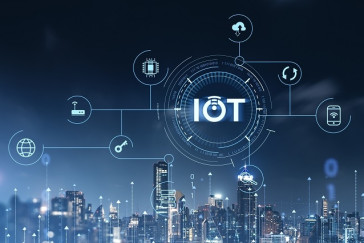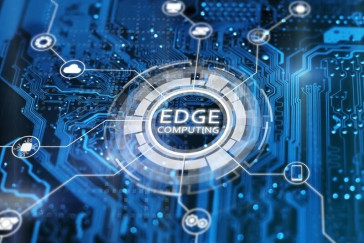IoT Edge Computing: The Future of Real-Time Data Processing

Internet of Things (IoT), thus bringing the world closer. Data could be generated anyplace: an intelligent thermostat learning your comfort levels, a smartwatch tracking your health, or industrial sensors monitoring the manufacturing processes. The challenge, however, is not just gathering this data, but also to make sense of it while it is happening. IoT Edge Computing enters under this transformative approach that brings data processing tasks closer to where data generation takes place.
What Is IoT Edge Computing?
Processing of data closer to where it is generated, at or near the "edge" of the network, is called IoT Edge Computing. Instead of sending all data collected by IoT devices to a cloud data center for processing, edge computing processes data quickly at or near the source of data acquisition. This drastically reduces the time within which devices can respond to changes in the environment, thus conserving bandwidth and reducing pressure on cloud infrastructure.
Learn More: Get The Best 5G Network Expansion News And Latest Updates
To illustrate, consider a smart home security system, which includes cameras and motion sensors. Instead of sending every piece of data to the cloud for analysis, the system can process relevant video footage and motion events in real-time locally to determine if an intruder is present and set off an alarm. Such instant responses would not be possible if the system relies on cloud processing where the network connection happens to be slow or intermittent.

Edge Computing vs. Cloud Computing
Cloud Computing
Cloud computing is a model that involves storing and processing data remotely on centralized servers located in data centers. This approach offers numerous benefits, including scalability, flexibility, and centralized data management. Cloud computing allows organizations to process and store massive amounts of data, and to perform complex analytics and machine learning tasks, thanks to the vast computing resources available in the cloud.
However, while the cloud offers enormous computational power and storage capacity, it also introduces certain limitations, particularly in terms of latency. When an IoT device sends data to the cloud for processing, it must travel across networks that can experience delays, leading to increased response times. In some cases, this delay may be tolerable, but for time-sensitive applications like autonomous driving or real-time medical monitoring, even milliseconds of delay can be disastrous.
Edge Computing
Edge computing resolves these boundaries by processing data as near to the source as possible. Analyzing data on local devices or near edge servers is one of the functions provided by edge computing, allowing real-time decision-making involving a very low latency. In the event of an autonomous car, it can allow the vehicle to receive and process data from its sensors and cameras on the spot, making it able to respond instantly to issues such as braking or steering by preventing consult with distant cloud servers.
This will reduce the pressure placed on the network infrastructure since much of the processing is done at the edge, which eliminates the need to move huge amounts of data over the cloud. This will be most useful with applications that are barely networked or quite marginal, where internet connectivity is limited or poor and where costs are high - such as in remote locations, rural areas, and places where network coverage is less intense.
Cloud computing is most used for applications that require analyzing a lot of data or keeping it for a long time, while real-time data processing can be possible only through edge computing. While more IoT devices come to life in different environments, both edge and cloud computing will complement each other. Edge computing will handle the immediate requirements that need to be executed at very low latencies, while the cloud will gather all data in a global storage and process high-end analytics.
Applications of Edge Computing
Autonomous Vehicles
Self-driving cars, trucks, drones, and other autonomous vehicles are one of the many reputable applications of edge computing. These vehicles continuously monitor their surroundings and navigate safely using different kinds of sensors, cameras, and radars. For example, when an autonomous car detects a pedestrian crossing the street, it needs to react in less than a millisecond to avoid hitting him.
Real-time data processing at the edge is a good use for edge computing. A moment's delay could endanger life if the data needs to be sent over the cloud for processing. With the application of edge computing, the autonomous vehicle processes data on-site at the very edge to make instantaneous decisions regarding its actions to navigate safely and efficiently.
Smart Cities
The notion of smart cities has incredibly gained significance, especially among the urban places seeking technological inputs to improve their infrastructure and services. These range from intelligent traffic management systems to energy-saving streetlights to waste disposal and managing air quality, and edge computing actually helps in making cities smarter and sustainable.
For instance, traffic sensors can detect congestion in real time and adjust traffic light patterns accordingly, helping to alleviate traffic jams and reduce pollution. Similarly, sensors in waste bins can notify waste management teams when they are full, optimizing the collection process. By processing data at the edge, these applications can operate autonomously without the need for constant cloud connectivity.
Industrial IoT (IIoT)
The industrial internet of things (IIoT) thus consists of sensing and controlling things related to the ongoing processes in manufacturing, logistics, and other industrial sectors through connected devices. The installation of edge computing granularity is advantageous in IIoT applications due to real-time processing of sensor data, whether pertaining to machine health, environmental conditions, etc., to enhance operational decision-making and to alleviate downtimes.
In an industrial setting, an industrial robot can exploit edge computing to detect movements or vibration patterns that deviate from the norm, although the ones indicating a mechanical failure. To offset this, such incidences are dealt with in real-time by an IIoT system, thereby preventing maintenance costs of that machine, averting accidents, and prompting production efficiency.
Check This Out: Consumer Trends And The Rise of Subscription Service News
Healthcare Devices
For the entire healthcare spectrum, the ability to monitor the patient's health condition in real-time is crucial. Wearable devices like smartwatches or heart-rate monitors collect data continuously about some important vitals of a patient. Edge computing allows for immediate analysis of this data on the wearable device itself or on a nearby gateway, allowing for the safety of immediate alerts if the patient's actual condition changes significantly.
For example, when the heart rate of a patient goes in a dangerous range, the device can issue an alert to the user or to a healthcare professional without needing to send the data first to the cloud. This is important, especially in critical care situations, where every second counts.
Retail and Supply Chain
Retailers and supply chain operators are increasingly turning to IoT devices to track inventory, manage shipments, and optimize customer experiences. Edge computing enables these processes to be managed in real time.
For example, smart shelves equipped with weight sensors and RFID tags can detect when products are running low and automatically reorder them from suppliers. Similarly, edge computing allows supply chain operators to track shipments and adjust delivery routes based on real-time data, reducing delays and improving efficiency.
Global Implications of Edge Computing
Westmark Network Reduced Congestion Spurt
Other devices have increased the number of devices connected through the internet. Network congestion has become a great threat. The tremendous data that each device generates due to the connected IoT is on the verge of congesting old infrastructure; urban areas, that is, which have an overwhelming density of devices. Edge computing is the solution to the data processing that it provides locally, thus decreasing using massive amounts of data in transferring through the internet. The end result is congestion-free, smooth, and better-performing networks.
Data Privacy and Security Enhancement
Data privacy and security remain drawbacks in the digital world, as increasing devices continue to be connected. Data is processed on the edge and reduces sending sensitive information through networks, resulting in a decrease in the number of data breaches or cyber-attacks. Since edge devices can also be secured separately, an organization can enforce finer-grained security controls for sensitive information.
Improve the Decision-Making Process Globally
Making decisions faster becomes vital for industries such as healthcare and transportation as well as the manufacturing of products. Real-time data processing is available with edge-computing technology, which makes it possible for any organization to respond to events or take decisions within no time. This technology's advantage is immensely felt in critical environments, such as within hospitals or on the factory floor, where delays in making decisions could have serious repercussions.
Empowerment of Remote Regions
Most distant or even rural places are not well connected to the internet or cloud infrastructure. Edge computing makes it possible to deploy local data processing, despite the connectivity limitations of some areas. This will empower communities in those isolated areas by opening access to advanced technologies and services like telemedicine, smart agriculture, and autonomous transportation.
Environmental Sustainability
One way edge computing promotes environmental sustainability is by minimizing the energy consumption involved in moving data from one point to the other through huge transmissions to clouds. Processing data locally through edge computing also means that few energy-intensive data centers will be required, thereby lowering carbon footprints and advancing the goals of global sustainability as a whole.
Top Edge Computing Performers
NVIDIA
NVIDIA is a key player in the edge computing space, particularly in industries that require high-performance computing, such as autonomous vehicles and robotics. The company's Jetson platform allows for powerful AI and machine learning applications at the edge, enabling real-time processing and decision-making.
Cisco Systems
Cisco is a leader in networking and edge computing, offering solutions that enable efficient and secure data processing at the network edge. Cisco's Edge IoT solutions provide robust infrastructure for industrial IoT, smart cities, and other edge-based applications.
Edge Computing Services
AWS provides a host of edge computing services, such as AWS IoT Greengrass and AWS Snowcone, that enable pushing cloud-like features to the edge. With the global infrastructure and cloud services, AWS builds an environment that is readily seamless and friendly for connecting these edge devices to the cloud.
Microsoft Azure
Microsoft Azure's IoT Edge platform allows the deployment of cloud workloads on edge devices, facilitating real-time data processing and analysis. Azure IoT Edge helps customers consume their existing cloud infrastructure while deriving advantages from edge computing.
IBM
IBM also renders its edge computing services through its Edge Application Manager and its Watson AI platform, edge-enabled. Edge computing from IBM is often consumed in industries like healthcare, finance, and manufacturing verticals with a strong case making real-time data analytics important.
Also Read: Top Cloud Storage Services for Personal and Business Use
Conclusion
It is no longer a far-off concept; it is a mega-reality in transforming industries globally. Edge computing concerns real-time decision-making nearer to the source, decreased network load, and enhanced data privacy and security. As such, the more IoT end devices proliferate, the more such provisions for edge computing become indispensable for autonomous applications in particular areas such as vehicles, health sectors, smart cities, etc. Edge is the future of IoT and data processing; the companies and technologies superior in this attribute would make the difference in how history will go.
This content was created by AI





